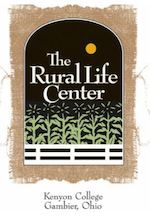-

Life Along the Kokosing
This tour guide of sites along Knox County's Kokosing River explores our relationship to nature and rural community identity. The guide includes thirteen five-minute audio programs featuring excerpts of interviews with residents about the sites and a forty-page booklet with photographs and additional historical materials. Topics include village and town history, Amish community, agriculture, floods, recreation, immigration, the economy, geological history, wildlife, green space preservation, and urban sprawl.
Track listing:
-
Intro: At Riverside Park
-
Waterford
-
Kokosing Resevoir
-
Kokosing Sand and Gravel Pit
-
Cassell Farm
-
Mount Vernon Viaduct
-
Andrew Craig Historical Marker
-
Brown Family Environmental Center
-
Kenyon Mill
-
Indianfield Run
-
Trestle Bridge
-
Kokosing Valley Camp and Canoe
-
Millwood
-
Greer
-
Outro: Kokosing Farewell
-
-

Foodways
This series features essays, biographical sketches, photographs, and recipes exploring food and community life in Knox County. Topics include gardening, hunting and trapping, food markets, the economics of food, new farmers, feeding the hungry, eating out, ritual food, cooking, canning and preserving, food and healing, and food choices. The series is based on extensive field research.
-

The Mayos: African-American Artists of the Heartland
This oral history project and exhibit pays tribute to two outstanding African-American folk artists with roots in Mount Vernon, Ohio: Walter O. Mayo (1878-1970) and his son, Walter L. “Bud” Mayo (1908-2000). Kenyon students Margaret Tazewell (’03) and Jessica Philips (’04) conducted interviews with family and community members, traced and documented artworks in the community, and mounted an exhibit and public conversation at Kenyon’s Olin Gallery in January 23-February 23, 2003.
-

What's For Dinner?
This nine-cube tabletop exhibit explores the implications of our food choices for us as individuals and for our community. Each cube explores a different implication of our food choices-- for nutrition, health, food production, economics, politics, and the environment. Materials presented include discussion of a food product and biographies of people related to the local food system. Copies are currently on display in restaurants, libraries, school cafeterias, medical offices, and assisted living centers.
-

Where Does Our Food Come From?
This twenty-two-panel exhibit traces Knox County's food system from farm to table. Drawing on interviews and fieldwork with dozens of local residents, including farmers, food processors, truckers, restaurant owners, and consumers, the exhibit consists of photographs and text that provide a unique perspective on the food we eat and the character of rural communities. The exhibit debuted at Kenyon College in May 2006 and has been featured at the Knox County Fair and the Centerburg (Ohio) Oldtime Farming Festival. This exhibit is on permanent display at Malabar Farm State Park in Lucas, Ohio. "Where Does Our Food Come From?" is also the title of a seven-minute film that explores the many reasons for buying locally.
-

The Place To Be
Public life brings us together in common activity: cheering on the school sports team, enjoying Sunday dinner at a favorite restaurant, shopping at a local store. In these public spaces we conduct business, swap recipes, discuss issues of the day, relax with friends, and welcome newcomers to town. Public life knits together the diverse elements of a community and fosters a sense of civic responsibility. But longer job commutes, greater popularity of home entertainment, and online shopping mean more time spent privately and fewer opportunities to get together. To retain vitality, communities must continually nurture their traditional gathering places and invent fresh opportunities to enjoy the company of others.
The Place to Be is the project of a sociology seminar conducted in 2011–2012 at Kenyon College, Gambier, Ohio. The project was directed by Professor Howard L. Sacks and conducted by students Trudy Andrzejewski, Anna Becker, Sarah Bush, Margaret Higby, Rebecca Katzman, Rachel Keller, Leslie Lasiter, Christian Martinez-Canchola, Kelly McPharlin, Melissa Straus, Daniel Tebes, William Udell, Colin Walker, and Marika West. Special thanks to all of the community members who so warmly welcomed us and shared their experiences. Additional thanks to Mike Andorfer, Jim Gibson, Janet Jacobs, Janis Johnson, Mark Ramser, Lynne Ricard, and Matt Starr. Unless otherwise noted, photos are courtesy the Rural Life Center.
Design: Nanette Black, N. Black Design Editorial services: Judy Sacks Exhibit fabrication: Applied Graphics Ltd., Central Ohio Fabricators Film production: I-CONN Video Production
The Place to Be is a presentation of the Rural Life Center at Kenyon College. The Rural Life Center promotes education, scholarship, and public projects about Knox County, Ohio. In active partnership with the surrounding community, we seek to ensure the vitality of rural life in a changing society. For further information, visit our Web site at http://rurallife.kenyon.edu.
This exhibit is part of an initiative, Rural by Design, promoting rural sustainability in Knox County and is made possible with support from the McGregor Fund of Detroit, Michigan. The McGregor Fund is a private foundation established in 1925 by gifts from Katherine and Tracy McGregor “to relieve the misfortunes and promote the well-being of mankind.” The foundation awards grants to organizations in the following areas: human services, education, health care, arts and culture, and public benefit. Visit http://www.mcgregorfund.org/ for additional information.
Printing is not supported at the primary Gallery Thumbnail page. Please first navigate to a specific Image before printing.


